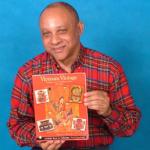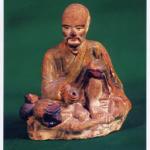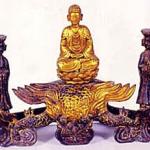Vietnam Vintage: An Interview with William Mitchell
William Mitchell has come a long way from his down-home beginnings in Raleigh, North Carolina. Now a resident of Yangon, Myanmar, this high school teacher, Asian antique collector, and author of Vietnam Vintage, known to his friends as Mitch, is surprised, in retrospect, where the path through life has taken him.
"I'm still surprised in all respects," he says. "Although travel was at the back of my mind. Travel outside the military was not a part of the neighborhood landscape. All the people I knew who went to Asia went there to shoot at somebody. The idea of collecting oriental stuff would have seemed weird. There is nothing I can think of in my background that would have predicted this course. I suppose that if someone had said I would travel, I would have said 'fine.' If they added to that, 'and you shall collect antiques from dusty shops along narrow streets in Asian countries,' I would have responded, 'Er, I doubt it.'"
But that's exactly what he did...and does. After finishing high school in Raleigh, and college at St. Andrews College about 120 miles away in Laurinburg, Mitch headed to Illinois for graduate school. "I flirted with M.A.'s at Southern Illinois University and University of Chicago, where I mostly went to blues clubs," he remarks in a droll aside, "before going into the Peace Corps in 1979. I worked in Bignona, Senegal, West Africa. I was a teacher of English at a Catholic school called College Reny Coly. Bignona is a town of less than 5,000 people. At that time (1979-81) there were two Americans there including me. I later finished an M.A. in Teaching English as a Second Language at Ball State University in Muncie, Indiana in 1988."
Since then, his travels have taken him to Canada, Senegal, Saudi Arabia, Jordan, Greece, Western Europe, Thailand, Cambodia, Vietnam, and to the Philippines, where he met his wife Evangeline.
"I met my wife in the Philippines at Morong, Bataan. This was the site of a camp for Vietnamese, Lao, Khmer, and Hmong refugees. She was an ESL teacher, and I was there as a supervisor and trainer of ESL teachers. She came to the camp in 1980, and I arrived there in 1986. I left the camp in 1991 to work at JVA (Joint Voluntary Agency) in Bangkok, assigned to the U.S. Orderly Departure Program. ODP is what got me on regular rotation into Vietnam beginning 1992 as a senior case worker. Anyway, Evangeline (Vangie) and I were married in 1994 in a garden wedding in Baguio City, Philippines, her home. We have two daughters, Diwa (7) and Mithi (6) both born in Bangkok. Respectively, their names mean "wisdom" and "ambition" in Tagalog language. But at this time, I really think their names mean 'living terrors.' They are quite active and intelligent."
Mitch and Evangeline's latest pin on the map has landed them in Yangon, Myanmar. And when asked, "Why Myanmar?" he replies, "Good question. We are still asking ourselves. When we left Vietnam, we were either going to return to the States or go to China. We ruled out both pretty much because of Old Man Winter. China was tempting but education for our kids was a problem. I wanted something a bit more interesting than Wilson, North Carolina, where we had job offers. The school here in Yangon agreed to let our children study for free. And, we both like Asia so here we are."
When he isn't teaching, Mitch enjoys spending time by himself, watching historical movies, listening to jazz and reading science fiction. But his first love is collecting Asian antiques. So much so, that he has even written a book, Vietnam Vintage, based on his own private collection.
"For some time, friends of mine had been advising me to write something about my collection. I was in Raleigh in April 2002, mainly to spend time with my mother, who was not doing so well at that time. I bought a book titled Chinese Country Antiques, published by Schiffer Press. I checked the Schiffer website where there is an area for book proposals, and when I returned to Vietnam in May, I sent a proposal. They wanted to see photos and a sample chapter. After seeing slides of my collection, Schiffer agreed to publish Vietnam Vintage. I found a photographer in Vietnam through the help of a student I was tutoring. He has a musty, dusty studio in District 11. I wrote the book with everything done via the Internet. I got the proofs through DHL just two days before leaving Vietnam to come to Myanmar."
When asked how it all began, and whether he was a collector of rocks, found objects and comic books as a child, Mitch recalls, "I did not really collect anything, although I was a comic book freak and I had quite a, well, collection of them. I did, however, drive my Grandma Bertha crazy with questions about the stuff that used to be in the shed near her house. I was fascinated with old farm stuff and what people did and how they did it when she was a young girl. Grandma died at the antique age of about 102. I often think of her when I'm out looking for things."
With the extent of his growing collection, it seems inevitable that Mitch will someday become an antique dealer himself. "I will likely get into the business in the future," he says. "At least part time, because there is no way for me to keep all of this stuff I've collected since 1992. The items in the book are not all of the pieces I have. Many in Vietnam were not photographed for various reasons. Also, there is quite a bit in storage in Raleigh. Things from Vietnam, Thailand, Cambodia and a few other places. And now, I'm collecting more stuff from Myanmar. This is really an illness. I have to get professional help!"
Adventures in Antique Hunting
In the years since he began collecting, Mitch has made his share of memorable purchases and has met lots of eccentric characters along the way. One of his favorite memories is of an especially auspicious find. "Once, in a shop, I noticed something under a cabinet. It was just barely sticking out. I asked to see it. It was a tray with nine cloisonné dishes. The wood tray was badly damaged as were a few of the trays. I liked it. The owner was shocked and ashamed at how dirty it was and reluctant to sell such a dirty item. Later, I took it to another shop whose owner specializes in this type of ware. Turns out it was a late 18th or early 19th century piece of Chinese origin and certainly worth a lot more than the $30 I paid for it."
First among his many favorite characters, Mitch describes a Vietnamese independent antiques dealer who would later become a friend and mentor. "Certainly the most memorable was an old Vietnamese man with one eye who sold items to the shops in Ho Chi Minh City. He apparently had three wives and God knows how many children. He took a liking to me and I to him. I bought a lot of stuff from him. He was from the north near Hanoi and came down south about once a month. He often gave me old things that went unsold or, for what he charged, he might as well have given them to me. He was, more than any other person or book, my best teacher in terms of what all of these things were. He passed away several years ago. I miss him and often think about him."
And what international antique collector doesn't have a customs story to tell? "I was taking an oil lamp out of Vietnam," he recalls. "The customs official inspected the piece of gold lacquer over metal and gave me that look that bought out that voice in my head, 'Mitch, you ain't taking this out.' The official inspected it, admired it, and complimented me on my good taste. Then he said it was okay, as I had demonstrated good taste. He said so many others were trying to leave with shit, albeit old, and it was nice to see someone who chose well. Go figure."
Upon reading Vietnam Vintage, and seeing the many treasures in his collection, one might naturally be inclined to ask if Mitch has a favorite. "Careful on this one," he jokes. "If I choose one, the others will get mad, and trust me, you don't want a houseful of pissed off antiques. Ugly." However, in all seriousness, he continues, "Actually, there is a pair of wall panels of lacquer and mother of pearl depicting Immortals upon supernatural beasts I first saw the pair in a Ho Chi Minh City shop, but the price was scary. The price got even scarier as time went on, and on the wall of the shop they stayed for about a year. The shop owners are friends, and one day asked me to look into the immigration case of a friend of theirs who was already in the U.S. He was petitioning for a fiancée. Her case had been delayed and everyone was anxious about it. He passed this on to the shop owners and they to me. I had worked in immigration in Ho Chi Minh City, so I checked with friends of mine at the U.S. Consulate. Either they had not sent a letter to the fiancée to come for an interview or the letter had not reached her. Anyway, she got the invitation, was scheduled for an interview and approved. The guy came to Ho Chi Minh City for the interview and to help prepare for his sweetheart's departure. He went to the shop of my friends and, I suppose, he must have asked them about the things I liked. Before he left to return to the U.S., I was invited to a dinner with the shop owners, and the happy couple. At some point, I was presented with a package and when I opened it, guess what was there! I was speechless and shocked. Still am. Not only are these types of panels rare (I have seen only a few others), but they are expensive. Needless to say, I was very happy and have a special attachment to this gift."
Advice for Asian Antique Hunters
When it comes to collecting Asian antiques, Mitch's first rule is: Buy what you like. "If you really like it and the price is high, but still affordable and won't lead to death and reincarnation as an insurance salesman," he recommends, "Buy it."
Another good piece of advice entails determining authenticity. On that subject, Mitch says, "I always get to know shop owners who are also antique buffs. Not all of them are. I have a core of contacts who really know the items and are very helpful in this regard. These are also people I regularly buy from. Fakes are a big problem. The people who are helpful to me call my attention whenever I seem interested in things in their shops that are copies or not very old. Not only that, they take the time to educate me by showing me what to look for. Of course, they gleefully sell these things to others who come to their shops."
Mitch was even willing to reveal his favorite places to shop. "In Ho Chi Minh City, definitely Le Cong Kieu Street. I settled pretty much on two or three shops on this short, narrow, funky stretch of many dusty shops. But all of the shops are worth a look."
And one last piece of advice, he adds, "Buy my book!"
* * * * *
Vietnam Vintage by William Mitchell. 2004, Schiffer Publishing
* * * * *
 ThingsAsian
ThingsAsian



















